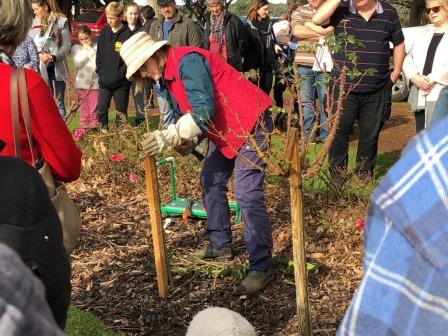Perhaps you’ve taken the step of planting some roses, you’ve enjoyed their fragrance and colour during the year, and now you’re feeling a little panicky at the need to prune shortly? Sandra Turner, President of the Victorian Rose Society explains how to do it.
When pruning all roses, you need to be prepared. Be dressed appropriately, have good gardening gloves – preferably elbow length. Correct tools such as sharp secateurs, loppers and a pruning saw are essential. You will also need a cloth and jar with diluted bleach to disinfect your tools as you prune your roses.
Pruning is best done in June & July, or if you’re in a frosty area it’s best to leave until August – you don’t want to prune your roses and then have a spell of sunny days causing the roses to shoot, as a following frost could damage the new growth.

𝐁𝐮𝐬𝐡 𝐑𝐨𝐬𝐞𝐬 – Cut your bush back by half or by two thirds of its height. Remove all dead wood or old canes which did not produce good growth in the previous season. Also remove any thin and twiggy growth and remove crowded branches. Always prune to an outward facing bud and cut on a slight angle about ½ cm above the bud.
𝐒𝐭𝐚𝐧𝐝𝐚𝐫𝐝 𝐑𝐨𝐬𝐞𝐬 – Use the same procedure as above whilst retaining a rounded ball shape.
𝐂𝐥𝐢𝐦𝐛𝐞𝐫𝐬 – Your climbing rose is unlikely to require pruning for the first few years. If it’s a juvenile, just tidy and remove any dead branches. During its youth is the best time to get your climber into the position to be a real show stopper. If you monitor your climber for a few years you’ll be able to observe its flowering habits. After spring flowering is generally the best time to prune your climber by removing any laterals back to a strong frame. If you’re planting a new climber, keep in mind that it’s often much easier in a pruning sense to simply tie the rose to its support. If you weave stems in an out, it makes the plant more difficult to prune. Plants which are tied back can easily be untied, pruned and tidied and then re-tied.
Do not remove the new long climbing canes, as these will produce next season’s flowers. Tie canes into position over the arch, or fan out against the structure they’re growing against. The more horizontally trained, the better. This will mean more laterals and therefore more flowers. Every couple of years, remove an old cane to ground level, which will encourage a strong new water shoot.
If you haven’t already done so, now is the time to apply Seamungus throughout your garden. The soil will be bursting with health and life, and when you apply your first application of Sudden Impact for Roses in spring, the results will be brilliant. I always like to mulch after pruning as well, as access is easier and there are less thorns to deal with. You’ll find that Whoflungdung keeps your soil temperature constant over winter, which means an optimum result when flowering starts. Let’s face it – we rosarians do love the flower.
Keep in mind that most rose societies and many gardens have rose pruning days – this is a great way to learn. Due to COVID 19 that will not be the case this year, but I recommend that you keep an eye on your state’s rose society website for updates next winter.


🌿 About Seamungus – Seamungus is a soil and plant conditioner, manufactured by combining the very best of composted raw materials – seaweed, fish, humic acid and manure. It is also a health tonic and planting food for all plants including natives, lawns and bare-rooted roses. Seamungus undergoes a unique composting process, specifically developed to stabilise the nutrients, maximise nutrient availability and to ensure the product is free of any parasites, pathogens and weed seeds. Most importantly, the resultant product retains the microbiology necessary for a ‘living’ product.
Whilst Seamungus contains a wide range and good levels of plant nutrients, it is perhaps the additional unique properties contained within seaweed that provide the catalyst for providing higher yields of sustained quality. Seamungus will help your plants resist heat, drought and frost, along with pests and disease. It will retain up to 70% of its own weight in moisture – significantly increasing the soil’s ability to hold onto water and nutrients.
